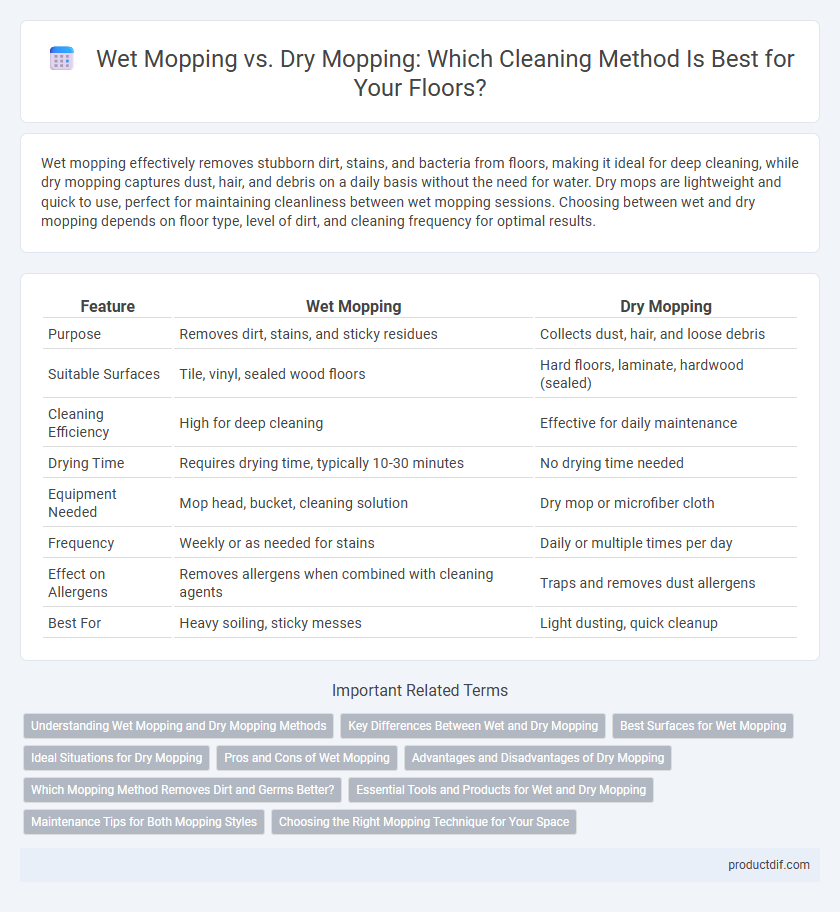Wet mopping effectively removes stubborn dirt, stains, and bacteria from floors, making it ideal for deep cleaning, while dry mopping captures dust, hair, and debris on a daily basis without the need for water. Dry mops are lightweight and quick to use, perfect for maintaining cleanliness between wet mopping sessions. Choosing between wet and dry mopping depends on floor type, level of dirt, and cleaning frequency for optimal results.
Table of Comparison
| Feature | Wet Mopping | Dry Mopping |
|---|---|---|
| Purpose | Removes dirt, stains, and sticky residues | Collects dust, hair, and loose debris |
| Suitable Surfaces | Tile, vinyl, sealed wood floors | Hard floors, laminate, hardwood (sealed) |
| Cleaning Efficiency | High for deep cleaning | Effective for daily maintenance |
| Drying Time | Requires drying time, typically 10-30 minutes | No drying time needed |
| Equipment Needed | Mop head, bucket, cleaning solution | Dry mop or microfiber cloth |
| Frequency | Weekly or as needed for stains | Daily or multiple times per day |
| Effect on Allergens | Removes allergens when combined with cleaning agents | Traps and removes dust allergens |
| Best For | Heavy soiling, sticky messes | Light dusting, quick cleanup |
Understanding Wet Mopping and Dry Mopping Methods
Wet mopping uses water or cleaning solutions to remove dirt and stains from floors, making it highly effective for deep cleaning and sanitizing surfaces. Dry mopping relies on microfiber or dust mops to capture dust, dirt, and debris without moisture, ideal for daily maintenance and preventing dust accumulation. Choosing between wet mopping and dry mopping depends on floor type, cleaning frequency, and the desired level of cleanliness.
Key Differences Between Wet and Dry Mopping
Wet mopping uses water and cleaning solution to remove dirt, grime, and stains, making it ideal for deep cleaning and sanitizing hard floors. Dry mopping employs a microfiber or dust mop to lift dust, hair, and loose debris without moisture, perfect for quick maintenance and reducing allergens. Wet mopping requires drying time and may cause floor damage if overused, whereas dry mopping is faster and safer for delicate surfaces.
Best Surfaces for Wet Mopping
Wet mopping is ideal for hard, non-porous surfaces such as tile, vinyl, and sealed hardwood floors where moisture can effectively lift dirt and grime. Porous materials or untreated wood may absorb water, leading to damage, so wet mopping should be avoided on these surfaces. For optimal cleaning, use wet mopping on smooth, sealed floors that can withstand moisture without warping or staining.
Ideal Situations for Dry Mopping
Dry mopping is ideal for removing dust, dirt, and pet hair from hard floors like hardwood, laminate, and tile without using water or cleaning solutions. It is most effective in high-traffic areas where quick, daily maintenance is needed to prevent dust buildup and maintain a clean appearance. Dry mopping also helps protect delicate floor finishes by avoiding moisture-related damage common with wet mopping.
Pros and Cons of Wet Mopping
Wet mopping effectively removes dirt, grime, and sticky residues, offering a deeper clean compared to dry mopping. It excels in sanitizing hard floors by using water and cleaning solutions, making it ideal for removing bacteria and allergens. However, wet mopping requires longer drying times and can cause damage to sensitive flooring materials like untreated wood if overused.
Advantages and Disadvantages of Dry Mopping
Dry mopping effectively captures dust, dirt, and hair from hard surfaces without the use of water or cleaning solutions, making it an eco-friendly and quick cleaning option. It reduces the risk of slip hazards and prevents moisture damage on sensitive flooring materials such as hardwood or laminate. However, dry mopping may not eliminate sticky residues or deep-seated grime, often requiring periodic wet mopping or spot cleaning to maintain optimal cleanliness.
Which Mopping Method Removes Dirt and Germs Better?
Wet mopping effectively removes dirt and kills germs by using water and cleaning agents that dissolve and sanitize surfaces, making it ideal for disinfecting floors. Dry mopping primarily captures loose dust and debris but lacks the ability to eliminate bacteria or sticky residues. For thorough cleanliness and germ removal, wet mopping provides superior results compared to dry mopping.
Essential Tools and Products for Wet and Dry Mopping
Wet mopping requires a high-quality microfiber mop, a bucket with a wringer, and an appropriate cleaning solution such as a neutral pH floor cleaner to effectively remove dirt and stains while protecting floor surfaces. Dry mopping relies on electrostatic dust mops or microfiber dusters designed to capture dust, hair, and debris without spreading particles around. Choosing the right mop head material and cleaning products tailored to the specific floor type enhances cleaning efficiency and prolongs the lifespan of flooring.
Maintenance Tips for Both Mopping Styles
Wet mopping requires timely rinsing and wringing of the mop to avoid spreading dirt and excess water, which can damage floors and promote mold growth. Dry mopping benefits from regular vacuuming or sweeping beforehand to capture loose debris, ensuring effective dust removal without scratching surfaces. Both methods demand proper mop cleaning and drying after use to maintain hygiene and prolong the lifespan of the cleaning tools.
Choosing the Right Mopping Technique for Your Space
Wet mopping excels at removing tough stains, dirt, and grime from hard floors, making it ideal for heavily soiled areas and kitchens. Dry mopping effectively captures dust, hair, and debris, maintaining cleanliness with minimal moisture, perfect for hardwood and delicate surfaces. Selecting the right mopping technique depends on floor type, soil level, and desired maintenance frequency to ensure optimal cleanliness and floor longevity.
Wet mopping vs Dry mopping Infographic

 productdif.com
productdif.com